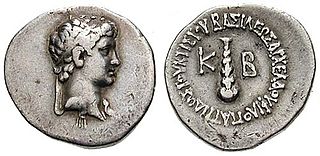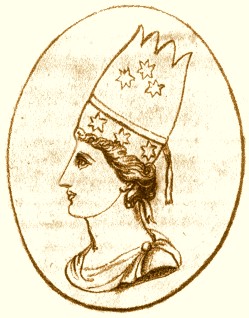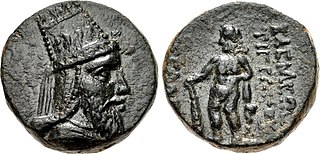Related Research Articles

Pietas, translated variously as "duty", "religiosity" or "religious behavior", "loyalty", "devotion", or "filial piety", was one of the chief virtues among the ancient Romans. It was the distinguishing virtue of the founding hero Aeneas, who is often given the adjectival epithet pius ("religious") throughout Virgil's epic Aeneid. The sacred nature of pietas was embodied by the divine personification Pietas, a goddess often pictured on Roman coins. The Greek equivalent is eusebeia (εὐσέβεια).
Archelaus was a prominent Greek general who served under King Mithridates VI of Pontus in northern Anatolia and was also his favorite general.

Archelaus was a Roman client prince and the last king of Cappadocia. He was also husband of Pythodorida, Queen regnant of Pontus.

Marcus Antonius Polemon Pythodoros, also known as Polemon II of Pontus and Polemon of Cilicia, was a prince of the Bosporan, Pontus, Cilicia, and Cappadocia. He served as a Roman client king of Pontus, Colchis, and Cilicia.

Erato was a queen of Armenia from the Artaxiad dynasty. She co-ruled as Roman client queen in 8–5 BC and 2 BC–AD 1 with Tigranes IV. Erato reigned alone in 1–2 AD. After living in political exile for a number of years, she co-ruled as Roman client queen from 6 until 12 with Tigranes V, her distant paternal relative and possible second husband. She may be viewed as one of the last hereditary rulers of her nation.

Tigranes VI, also known as Tigran VI or by his Roman name Gaius Julius Tigranes was a Herodian prince and served as a Roman client king of Armenia in the 1st century.

Tigranes V, also known as Tigran V was a Herodian prince who ruled as a Roman client king of Armenia from 6 AD to 12 AD.

Glaphyra was an Anatolian princess from Cappadocia, and a Queen of Mauretania by her second marriage to King Juba II of Mauretania. She was related to the Herodian dynasty by her first and third marriage, to Alexander, son of Herod and Herod Archelaus respectively.

Artavasdes IV of Armenia; also known as Artavasdes II of Atropatene; Artavasdes II of Media Atropatene and Armenia Major; Artavasdes II, and Artavasdes was an Iranian prince who served as King of Media Atropatene. During his reign of Media Atropatene, Artavasdes also served as a Roman Client King of Armenia Major.
Dionysius of Cyrene, lived c. 150 BC, was a Stoic philosopher and mathematician.
Gepaepyris was a Thracian princess, and a Roman Client Queen of the Bosporan Kingdom, the longest known surviving Roman Client Kingdom. She ruled in AD 37/38–39.
The Lex Cornelia de maiestate was a Roman law passed by Sulla during his dictatorship from 81 to 80 BC using the tribune Cornelius. The law, relating to the control of governors and their forces in the provinces, stated among other things that a governor could not leave his province during his time in office, with or without his army. The law was designed to prevent both corruption and rebellion of governors, but was thwarted just four years later in 77 BC during the revolt of Lepidus, a rogue proconsul who left his province of Cisalpine Gaul with his army and marched towards Rome.

Cappadocia was a province of the Roman Empire in Anatolia, with its capital at Caesarea. It was established in 17 AD by the Emperor Tiberius, following the death of Cappadocia's last king, Archelaus.
Neoptolemus was a distinguished general of King Mithridates VI of Pontus. He was the brother of Archelaus, another general of Mithridates VI and the paternal uncle of Archelaus’ sons: Archelaus and Diogenes.
Archelaus I was a high priest of the temple-state of Comana in Cappadocia and Egyptian royal consort.
Archelaus II was a High priest of the temple-state of Comana, Cappadocia.
Glaphyra was a hetaera, a form of courtesan, who lived in the 1st century BC. Glaphyra was famed and celebrated in antiquity for her beauty, charm and seductiveness. Her marriage to Archelaus the elder of Cappadocia gave her political power. Her later affair with Mark Antony occasioned a vulgar poem from Octavian Caesar.
Gaius Julius Alexion was a Syrian Prince and Roman Client Priest King of Emesa. He was the son of Syrian king Sohaemus and Queen Consort Drusilla.
Alexander II, also known by his Roman name Gaius Julius Alexander was a Herodian prince.
Lucius Calpurnius Proculus was a Roman governor of Dacia. He ruled Dacia for a period in the 160s, reign dates have been given variously as 161 to 164 AD and 162 to 167 AD. He hailed from Ancyra (Ankara), and was known to have owned an estate near Laodikeia. Calpurnius Proculus was killed by the Iazyges.
References
- 1 2 3 4 Tacitus, Annals, 6.41
- ↑ Wilson, Encyclopedia of ancient Greece, p.161
- 1 2 Levick, Tiberius the Politician, p.110
- ↑ Vogt, Aufstieg und Niedergang der römischen Welt: Geschichte und Kultur Roms im Spiegel der neueren Forschung, Volume 1, p.2091
- 1 2 Dueck, Strabo’s cultural geography: the making of a kolossourgia, p.208
- ↑ Sandler, Ground warfare: an international encyclopedia, Volume 1, p.884
- ↑ Mayor, The Poison King: the life and legend of Mithradates, Rome’s deadliest enemy, p.p.114&138
- ↑ Dueck, Strabo’s cultural geography: the making of a kolossourgia, p.205
- ↑ Rigsby, Asylia: territorial inviolability in the Hellenistic world, p.464
- ↑ Syme, Anatolica: studies in Strabo, p.162
- 1 2 Vogt, Aufstieg und Niedergang der römischen Welt: Geschichte und Kultur Roms im Spiegel der neueren Forschung, Volume 1, p.2093
- ↑ Syme, Anatolica: studies in Strabo, p.230
- ↑ Wolfgang Haase, Hildegard Temporini, Rise and decline of the Roman world, part 2, vol. 26, Walter de Gruyter, Berlin 1995, p. 1223